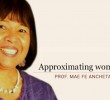Just two days before New Year and two days after my own daughter’s Catholic church wedding rites, the CBCP President, Bishop Socrates Villegas, made a statement that the wedding liturgy stands as is. Nothing should be added during the entire ceremony. Couples who want to make their own vows should share it instead at the reception.
My immediate reaction was: so what?
Let me recall that three decades since the United Nations’ declaration of Decade for Women (1975-1985), states have been under close scrutiny in reviewing policies and programs consistent with the twin-goal: women’s full development and elimination of all forms of discrimination against women. Gender mainstreaming has been a catch phrase among government and non-government organizations since then, taking into account history of women’s oppression and exploitation.
Aiming at an emancipatory process in the church, brides begin to consciously engage in the preparation of their church rituals just as they choose their entourage and dresses in the most fitting manner.
Symbols in rituals become more meaningful as enlightened women aspire to work for change in marital relations- giving more weight in the democratic family relations they want to build. Hence, vows have been reviewed as well in the hope of working out a meaningful and relevant wedding.
My recent transactions with the Catholic priests and nuns indicate a more accommodating liturgy-drafting. A sample creative liturgy was presented. It approximated gender-fair language and people’s interest in the construction of the entire liturgy.
The officiating priest reiterated a standard form reflective of the rubrics for wedding service. The draft had to be revised religiously following the rubrics, yet maintain the contents, particularly, the readings we introduced.
Building on the liturgy was a collective undertaking, concretely, engaging the priest in the process as he reminded the bride (and the groom) that any contents she wanted to add or change was her choice provided the standard outline is intact- in the mass and rites.
A post graduate student of theology, who was in my daughter’s special event, observed that the actual mass and rites held were indeed wonderful. It was in Filipino, which seemed to marvelously capture the essence of the vows shared by the couple.
To be critical about it, while the rites allowed the bride and groom to recite their personal vows, the community response to that solemn promise was absent. It came to mind that when I had my own rites- there were two responses: from my partner’s family and the women’s group. And sort of a tease — it was my daughter’s wedding not mine. It may be in some aspects progressive, but it could not be what I wanted it to be….only a portion because she asked for it.
True enough, there could be more progressive and creative wedding rites as personalities, orientation and social practice differ. But the challenge remains to the established church–to allow the vows integrated in the rites as to be dynamically rendered by the couple in ways they want to and in the spirit of thoughtfulness, non-sexism and communal concern for democratic relations.
Bishop Villegas may have his own interpretation of the sacredness of the wedding liturgy when he said: “The recitation of private devotion or personal spiritual expressions of the couple should not be allowed because this will only confuse, remove or diminish the focus on the sacred liturgy”.
“The liturgy is not ours to change at whim,” Villegas underscored.
“The regulation of the sacred liturgy depends solely on the Holy See and in limited cases, to bishops’ conferences. Hence, no other person, not even a priest may add, remove or change anything in the liturgy on his own authority.”
But for the many women, who have been into social development and human rights work, the matter is contentious. Inasmuch as we want to sustain affinity with the Catholic traditions, we also want to be part of the growing movement for a dynamic conduct of exchange of vows in marriage.
As members of the people’s church, women want to maintain the structure, yet express desire to come up with something unique for their rites as they pursue a partnership that promotes equity and empowerment which has to be set in the wedding ceremony itself.
Tolerance with progressive thinking will not destroy the sanctity of the wedding initiated at the Catholic Church as Pope Francis himself extols the Vatican 11 which encourages people-oriented actions.










